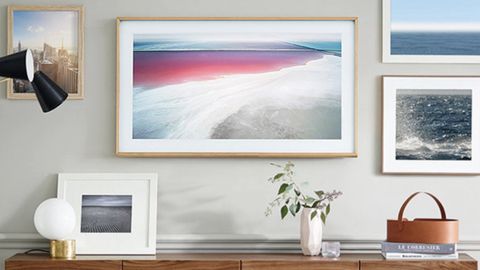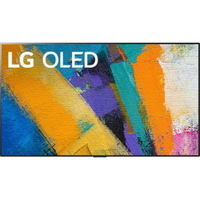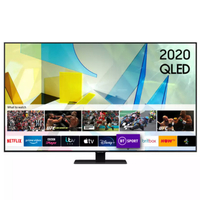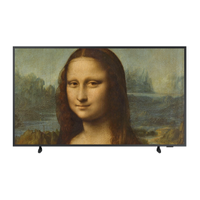TechRadar Verdict
Two years and two model iterations later – including a QLED panel and a host of new sizing options – Samsung The Frame (2020) is a much better proposition, even if some niggling complaints remain.
Pros
- +
Brilliant design
- +
Customizable bezel
- +
QLED panel
- +
Ambient Mode
Cons
- -
Low brightness
- -
Art Mode layout could be better
- -
No Google Assistant
- -
Some color issues
Why you can trust TechRadar
Two-minute review
Samsung The Frame TV (2020) is a TV that puts great design front and center. There are dedicated modes for accessing iconic artworks or ‘ambient’ imagery. As well as sleek cabling solutions, wall-mounting and bezel options that make it look like an actual picture frame.
The Samsung The Frame TV (2020) we're reviewing here wasn't the first version of The Frame. When we reviewed the previous version of The Frame in 2018, we found it to be a gorgeously-crafted television that nonetheless suffered in the picture department, with issues with color and brightness that stopped it feeling like a living room essential.
Screen Sizes: 32, 43, 50, 55, 65, 75-inch | Tuner: TVPlus | 4K: Yes | HDR: Yes | Panel technology: QLED | Smart TV: Yes, Tizen | Curved: No | Dimensions: 1121(w) x 642(h) x 458(d)mm | Weight: 13.3kg | 3D: No | Inputs: 4xHDMI 2.0, 2xUSB, ethernet, optical, terrestrial, cable input, satellite input, CI slot
Two years and two model iterations later—including a QLED panel and a host of new sizing options—Samsung The Frame (2020) is a much better proposition, even if some minor complaints with brightness and off-color images remain. You can read our Samsung The Frame TV (2018) review to find out more about how they compare.
Since the 2020 version, two more of the stylish TV models have been released. Read our Samsung The Frame TV (2021) review and our Samsung The Frame TV (2022) review if you'd like to see the latest models. Or take a look at our best Samsung TV guide for more from the TV maker.
However, that doesn't mean the Samsung The Frame TV (2020) isn't still worth your time. With a mix of TV sizes, different-colored bezels you can change on the fly, and a host of available artworks, wallpapers, and screensavers to display, The Frame really can cater to any number of homes, with a huge amount of variety in its appearance, function, and placement—whether it's wall-mounted or stuck on a counter.
It’s worth noting that the 2019 The Frame wasn’t available for review, meaning that Samsung is clearly more confident in their product this time around—which is largely warranted in our minds.
Read on for our full Samsung The Frame (2020) review, where we’ll cover the design choices, smart TV interface, Art and Ambient modes, and sound quality you’ll find when buying the 2020 version of The Frame.

Samsung The Frame TV (2020): availability and price
- Available in six different sizes, from 32-inch to 75-inch
- $1,299 / £1,399 / AU$1,799 for the 50-inch reviewed here
- Cheaper 2019 model still available
Samsung’s The Frame is available in the UK, US, and Australia—with some slight differentiation in sizes between those territories. The smallest 32-inch size is only available in the US for $599.
The 43-inch, 50-inch, 55-inch, 65-inch, and 75-inch models can now be found in all three territories, though.
We reviewed The Frame in its 50-inch size ($1,299 / £1,399 / AU$1,799). For other sizes, you’ll be paying $999 / £1,199 / AU$1,559 for the 43-inch, $1,499 / £1,599 / AU$2,295 for the 55-inch, $1,999 / £2,199 / AU$2,695 for the 65-inch, and $2,999 / £3,499 / AU$3,995 for the 75-inch.
It wasn't the cheapest QLED from Samsung in 2020, that was the Q60T. Check out our Samsung Q60T QLED TV review for more on that budget-friendly display, which retails at $529 / £799 (around AU$800) for its smallest 43-inch size. But the premium you pay on The Frame does bring a host of visual benefits (on the outside, at least).
Customizable frames start at $99 / £169 / AU$99, depending on the model size you're buying for.
Samsung The Frame TV (2020): design
- Excellent design
- Highly customizable
- OneConnect box is great for hiding cables
The most important aspect of The Frame is, naturally, the design.
More so than any other Samsung QLED TVs, The Frame is a television that puts appearances first. The idea is that, even if you’re a regular TV-watcher, there are probably hours of the day when you’re stuck with a big black rectangle dominating your living room—which is why The Frame has so many features designed to help it blend in with your home decor.
The base body of The Frame is a polished black metal: classy up close, but not very attention-grabbing from a few meters away. For a small addition to the cost of the television, though, you can buy a variety of bezels that attach magnetically for a full-on picture frame aesthetic: colors include white, black, brown, beige, burgundy red, and clay beige.
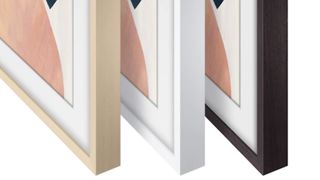
The Frame is a set that doesn’t try to be super slim—with a thick, quality-material bezel—but it has a very flattering silhouette, without a protruding rear or jutting parts. There’s space in the back of the television for a flush wall-mount to be attached; you can attach two solid feet to the underside of the display instead— thankfully, without having to using any screws—but the wall still feels like the natural home for The Frame.
The Frame (2020) was also one of the first Samsung TVs to feature the OneConnect box: a sleek cabling solution that outsources power, HDMI, USB ports and the like to a separate piece of hardware, to prevent numerous wires ruining the clean and classy look of your television. It’s a brilliant addition, especially here where the aesthetic is so crucial.
The rear of the box features four HDMI 2.0 ports (including eARC support), optical, ethernet, CI, satellite, Air/Cable, and ExLink, with two USB ports on the side—but even in 2020 it’s still incredible that one, near-invisible wire can carry all that information over to the display.
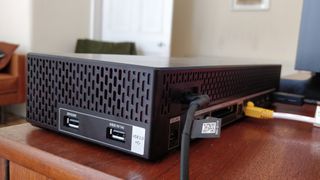
As with most high-end Samsung TVs, you get a pair of remotes: one basic remote with rubbery buttons and a full numerical keypad, and one ‘designer’ remote with a slimmed-down form factor and minimal button layout.
The sleek model is far more satisfying to hold and use, and carries dedicated buttons to Netflix, Amazon Prime Video, and Rakuten TV (in the UK, at least) as well as a ‘123’ button to easily type in channel numbers onscreen.
There are a couple of tricks worth checking the manual for—such as pressing in the volume button for mute—but nothing particularly frustrating. (A hint: pressing the power button once will switch between TV and Art Mode, but holding the button down will turn off the television entirely.)
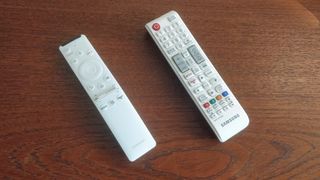
Samsung The Frame TV (2020): smart TV (Tizen)
- Tizen OS as great as ever
- Alexa and Bixby support
- Samsung TV Plus is an eye-sore
Samsung’s Tizen smart TV platform is one of the best in the business, and there’s little really to cover in this section.
Tizen makes use of a straightforward row of apps and services—which overlays over whatever app or content you currently have playing on the television—with a second content row that pops up above whatever app you’ve selected containing the programming available within it.
The app selection is customizable, too, meaning you can pin, delete, and rearrange what’s on show—so if you want Disney Plus ahead of Netflix, Rakuten TV between YouTube and Apple TV, or otherwise, that’s all right with The Frame. We might have expected a more streamlined or distinct layout, given the design focus of The Frame, but there really isn’t that much that could be improved (aside from the rather untidy Samsung TV Plus app, which is permanently half-visible at the bottom of the home screen, and a bit of an eye-sore).
You get two choices for voice assistant support, too, with both Amazon Alexa and Samsung’s in-house (and much maligned) Bixby assistant available.
As expected, Alexa works fine, and you can set up the set to work in conjunction with Amazon Echo smart speakers and other Alexa devices too. Bixby isn’t quite as capable, and we don’t particularly recommend it unless you're sticking to simple commands that jump between apps and source inputs—though there is a hugely useful set of Bixby commands listed in the TV’s Settings (e-Manual > Smart Features > Using Bixby) which is handy for knowing how exactly to speak to Bixby to get it doing what you want.
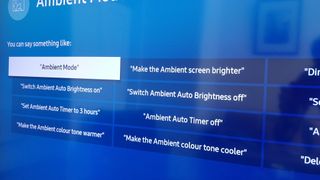
Samsung The Frame TV (2020): art mode/ambient mode
- Unique offering
- Hundreds of artworks (if you pay for them)
- News, clocks, and screensavers available in Ambient Mode
One of The Frame’s most distinctive features is Art Mode: a setting that displays artworks, paintings, landscapes, or your own personal photos instead of a black TV screen.
Notably, Samsung has partnered with a number of renowned museums and galleries, including the V&A and Saatchi Gallery in London, the Van Gogh museum in Amsterdam, and plenty others from around the world. Out of hundreds of artworks, you technically only get 20 for free, and you will need to upgrade to a paid monthly subscription to get a wider variety of paintings and the like—but there’s plenty of other background fodder to use without paying a penny.
The app’s layout could be improved, though: selecting Art Mode brings you automatically to a screen asking you to pay for the premium option (£3.99 per month in the UK), and the most useful sections—brightness and motion sensor settings, for one—aren’t visible unless you scroll down to ‘Spotlight’ and sift through the tabs that appear. Overall, though, Art Mode feels distinct and curated enough to make The Frame feel different from Samsung's other TVs.
We’re told by a Samsung rep that Art Mode uses around 30% of the power that streaming a movie on Netflix would, meaning it’s not as eco-friendly as simply turning the TV off, but is a good option for when you’re around the house a lot or having company over.
Ambient Mode is also well worth a look, utilizing—you guessed it—‘ambient’ animations and customizable color gradients to help generate a calming atmosphere (or just match the wallpaper as precisely as possible). The various clock faces and floating rubber duck are some personal favorites, but there’s plenty to try out here, including real-time weather information and news headlines supplied by Samsung’s upday news app.

Samsung The Frame TV (2020): picture quality
- Excellent upscaling
- Low brightness
- Some color issues
Samsung The Frame (2020) may be as pretty as a picture, but the actual picture quality isn’t always up to scratch.
It’s still a notable improvement on the 2018 model, helped by a newer Quantum Processor 4K, which ensures Samsung’s usual upscaling excellence is fully on show— with both HD and 4K sources looking crisp and detailed on The Frame’s 50-inch UHD screen.
Motion is highly smooth, too, with the action sequences in Scott Pilgrim vs The World looking as polished as we hoped, whether skateboards were raining down on the hero’s head or swords and hammers were swinging across the screen. The Frame automatically uses a Picture Clarity mode to aid with this, though we found motion entirely passable even without it.
Almost all the sources we tried looked great on Samsung The Frame’s QLED panel, with a couple of exceptions.
While some QLED panels can output thousands of nits brightness (important for illuminating the wider color gamut in HDR), The Frame is a bit dim by comparison, at only a few hundred. This is fine for everyday use—you certainly won’t need the Mona Lisa dazzling you at 2,000 nits —but it means the picture isn’t quite as impactful as some other Samsung TVs.
It also means that the set can struggle to show detail in darker scenes—especially with some ambient light in the room. It's not an issue most of the time, but means that shows that depend on dark environments to set the mood (Netflix's dystopian sci-fi Altered Carbon, for instance) can suffer. In these cases, we found the Movie picture setting was the best option to help out.
SDR (standard dynamic range) is fully capable here, with largely getting decent color recreation – as is fitting for an artistic television. HDR is where The Frame really looks best, with Samsung's proprietary dynamic HDR format, HDR10+, favored by Amazon Prime Video. We put HDR10+ to the test with the Amazon Original The Marvelous Mrs. Maisel, and were impressed by the vividly-colored costumes, dresses, and headwear throughout.
Skin tones aren’t always color-accurate, though—especially for non-white faces—and we found ourselves repeatedly switching between picture settings to try and amend this. When watching Mindy Kaling’s Netflix show Never Have I Ever, we found the default Standard setting gave the predominantly Indian cast a rather reddish tinge, with Cinema mode jumping to a slight green tint instead. It’s a slight issue, but disappointing nonetheless.
Samsung The Frame TV (2020): audio performance
Samsung The Frame TV may look good, but how does it sound? You’ll get a pretty standard 20W output here, without Dolby Atmos surround sound or any fancy built-in driver arrays (as with the Q950TS).
The Frame is more for looking than listening—but the sound still holds up for general usage. Dialogue is brilliantly clear, too, with an overall balanced sound, though you can start to hear some audio distortion when you get to higher volumes. This last point isn’t a huge issue, but enough to mean you’ll want a dedicated soundbar if you want to use The Frame for loud music or big-impact movie scores. Take a look at our best soundbar guide for our top recommendations.
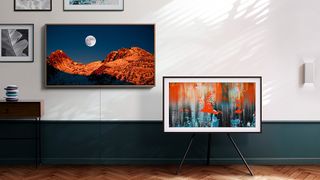
Verdict
There might be a new Samsung Frame TV in town, but the 2020 version we're reviewing here is still a solid option. It's best for those who want something a little different from their TV as it's designed to look great with a unique Art Mode for showcasing iconic artworks from museums and galleries around the world.
It'll also blend in with your decor thanks to the variety in sizing and coloring that'll help you match it to any home— its tidy OneConnect box helps matters too.
If you want a cinematic TV for movie nights, look elsewhere. Black crushing is an issue, especially for daytime watching—while the low brightness and meagre 20W audio means this isn’t the best home theater system out there.
This TV is for people who prioritize form over function. There are plenty of good TVs out there—plenty that are cheaper, too—but few have the style, or the artistic mindset, of The Frame TV.
Also consider...
If our Samsung The Frame TV (2020) review has you considering other TV options, here are three alternatives for you to check out.
LG GX Gallery Series OLED
The wall-mounted GX Gallery Series OLED from LG is also an artwork-minded television, but with 60W Dolby Atmos audio and an OLED panel thrown in. You’ll be paying around twice the price for an equivalent size—it's only available in 55-inch, 65-inch, and 77-inch—but the GX seems like a sensible upgrade if you have the cash to spend.
Read our LG GX Gallery Series OLED review
Samsung Q80T QLED TV
The Q80T is similar to The Frame TV, but has a wider viewing angle, which is good news if you're putting it in a space where it won't be solely enjoyed from a settee in front of it. It also has local dimmer and can get much brighter than The Frame TV.
Read our full Samsung Q80T QLED TV review
Samsung The Frame QLED 4K TV (2022)
If you're not tied to a budget and want a TV that looks great when you're watching it and when you're not, then splash out on the latest version of The Frame TV. New for 2022, an anti-reflection screen coating has been added to enhance viewers’ enjoyment of displayed artwork and photos when the TV is in Art mode.
Read our full Samsung The Frame QLED 4K TV (2022) review
- First reviewed in June 2020.
- Get the best deal on Samsung products with our Samsung coupon codes.
Henry is a freelance technology journalist, and former News & Features Editor for TechRadar, where he specialized in home entertainment gadgets such as TVs, projectors, soundbars, and smart speakers. Other bylines include Edge, T3, iMore, GamesRadar, NBC News, Healthline, and The Times.
